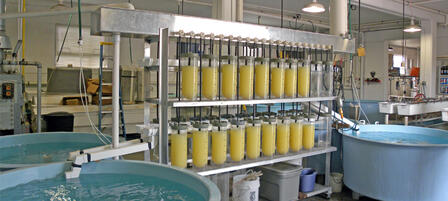Artificial Walleye Spawning Produces Real Results

PRATT – Maintaining healthy fish populations across the state that meet the desires of today’s anglers and fit within budget restraints is no easy feat, but Kansas Department of Wildlife, Parks and Tourism (KDWPT) Fisheries Division staff thrive in the face of this challenge. Walleye are popular with anglers, but few lakes in Kansas provide the necessary elements for adequate natural reproduction. The answer? Artificial spawning.
Every year about this time, fisheries biologists can be seen working tirelessly at select Kansas lakes, setting nets to capture spawning walleye. Eggs of ripe females are collected, and then taken to a station where they are fertilized with milt, or sperm, taken from male walleyes caught from the same body of water. After fertilization, the eggs are immediately delivered to the Pratt and Milford fish hatcheries where fish culturists work around the clock to ensure high hatch and survival rates of young walleye, which are then stocked into Kansas lakes as fry, or raised to a larger size for stocking. Sauger are also produced to ensure a supply of sauger males. Some walleye eggs are fertilized with sauger milt to create the saugeye, a popular hybrid.
Last year, the KDWPT Walleye Culture Program harvested nearly 100 million walleye eggs and produced the following for Kansas waters:
WALLEYE
-38 million walleye fry
-580,000 walleye fingerlings
-6,500 walleye intermediates
SAUGER
-2.7 million sauger fry
-More than 20,000 sauger fingerlings
SAUGEYE
-More than 6 million saugeye fry
-Approximately 310,000 fingerlings
This year, staff hope to harvest more than 100 million eggs and increase walleye production to stock 48 million walleye fry, and 1.2 million walleye fingerlings.
It’s hard to believe walleye would need any assistance in producing young of their own, especially since large females can produce upwards of 300,000 eggs, but research has shown less than 10 percent of naturally-spawned walleye eggs will successfully hatch. Thanks to the efforts of KDWPT’s hatchery staff, hatch rates can be as high as 70 percent in a controlled setting.
In addition to walleye, KDWPT hatcheries also produce bluegill, channel catfish, crappie, largemouth bass, redear sunfish, sauger, saugeye, smallmouth bass, striped bass, and wipers.
For more information on KDWPT hatcheries and the fish they produce, visit www.ksoutdoors.com and click “Fishing/Hatcheries.”
-30-









